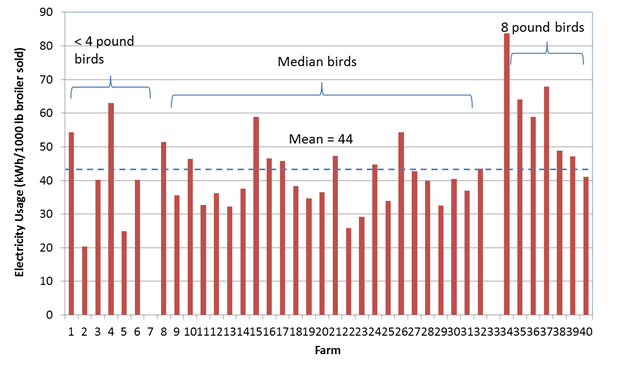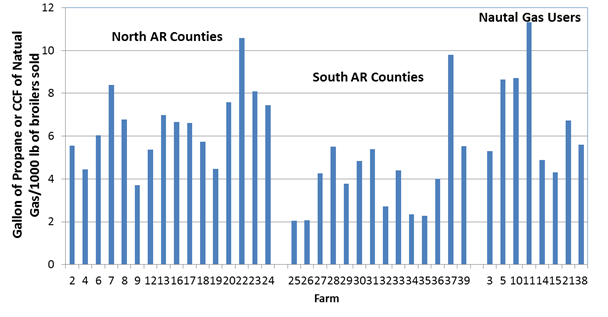Energy Conservation
Poultry Farm Energy Use Evaluation Program
Energy expenditure is the second highest expense for the contract poultry producers after the house mortgages, and is continuously on the rise. Energy related retrofits on a broiler farm can be expensive, and poultry growers need help in the on-farm energy use assessment or audit in order to apply for financial assistance programs. The University of Arkansas Poultry Farm Energy Use Evaluation program conducts farm energy audits for contract poultry producers in Arkansas. For details of the program please contact Dr. Yi Liang (yliang@uark.edu, 479-575-4862).
How Much Electricity Are You Using?
Broiler farms use electricity to power ventilation fans, artificial lights and small motors for feeders, etc. It is important to know your current energy usage in order to evaluate the magnitude of any energy efficiency improvement. The amount of electricity used varied considerably among the producers (see figure 1 below). The amount of electricity used is converted to per unit weight of broiler produced. Farms raising heavier birds tend to incur higher annual electricity than those raising lighter birds. The types of light lamps greatly determine electricity consumption.
What is your electricity consumption?
To determine it, divide the total kWh used during a two year period (to account for any year-to-year fluctuation), by the pound of live weight produced over the two years. Then multiply by 1,000. The high variation shown in the following graph (range of 20 to 83 kWh/1,000 pound of broiler sold, with mean of 44) indicates that opportunities exist for a farm to cut down electricity consumption.
The most cost-effective measure to reduce the electrical consumption is to upgrade to energy efficient lamps.
Figure 1. Electrical use by selected Arkansas farms

How Much Fuel Are You Using?
Poultry farms in the southern United States use either liquid propane or natural gas to heat the houses. It is important to know your current energy usage in order to evaluate the magnitude of any reduction. The amount of fuel consumption varies by geographic location of the farms (see figure 2 below). Annual fuel consumption was higher on farms in northern counties than those in southern counties.
What is your farm fuel consumption?
To determine your fuel consumption, divide the total gallon of propane or CCF (hundred cubic feet) of natural gas used during a two year period (to account for any year-to-year fluctuation), by the pound of live weight produced. Then multiply by 1,000. Again the high variation shown in the following graph (range of 2.0 to 10.5 gallon/1,000 pound of broiler sold, with mean of 5.8) indicates that opportunities exist for a farm to cut down fuel consumption. Common measures that could reduce cost of heating include tightening and increasing insulation of the barns, installing circulation fans, etc.
Figure 2. Fuel use by selected Arkansas farms

Estimating Fuel Savings by Ceiling Fans Installation